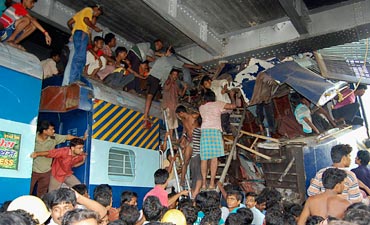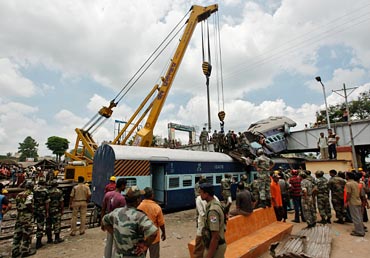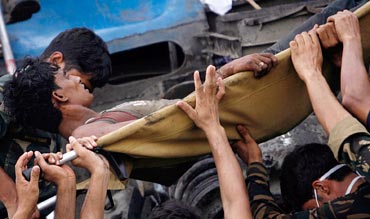 | « Back to article | Print this article |
'Signal failures are very common'
The railway ministry has faced scathing criticism about its efficiency and credibility in the last six months, after nearly 250 passengers lost their lives in various mishaps across the country.
Railway Minister Mamata Banerjee can continue to suspect 'sabotage' behind every mishap, but behind the claims of ensuring safety regulations, signals are flouted, human errors are neglected, funds are wasted and penalisations are seldom carried out.
In an interview with rediff.com's Anisha Ralhan, M G Arora, former executive director of safety, Indian Railways, explains how lobbyists and deflectors operating at different levels have corroded the lifeline of the nation.
Arora headed the Safety Directorate of the railways twice, between 1990 and 1994 and between 2000 and 2004.
Signal failure is suspected to be the cause behind the recent train disaster at Sainthia in West Bengal. Please explain how railway signals operate and the glitches reported during their operations.
There are two types of signal systems installed in India -- the Absolute Block System and the Automatic Block System. The Absolute Block System has to ensure that there is not more than one train on one line at any given point of time. Automatic, on the other hand, regulates the movement of more than one locomotive on one line.
In the case of the ill-fated Uttarbanga Express, the Absolute Block System was to alert the driver about the presence of another train at the Sainthia station by turning the red signal on but instead it showed green, which is likely to be a technical error that falls under the purview of the signal and telecommunications department and the operations department.
Signal failures are very common; (they are) witnessed on a daily basis on the railway tracks but the intriguing part in this tragedy is that it appears to be a product of a combination of factors including brake failure and driver error.
'Educated drivers have several attitude problems'
In the Sainthia tragedy, the driver had clearly violated the speed norms. How do you monitor human error?
Railway inspectors are required to make frequent trips with the driver to monitor him. Also, the job of an assistant driver is to ensure that the driver doesn't fall asleep.
A good driver is one who has never erred or even signal-passed danger. In railway vocabulary, signal-passing danger is when a driver is very close to a collision but averts it just in time. It is not the same as it is while driving on roads. Here, signal-passing danger is considered to be a serious crime, which results in immediate expulsion.
But if you ask me, in reality, these expulsions rarely happen. This is a management lapse. The disciplinary rules need to be renewed to ensure that flouters are duly penalised.
How would you reason out the driver's inefficiency?
Back in the 1960s and '70s, drivers were overworked but they had a sense of belonging to their country, to their profession. Today, educated drivers have several attitude problems. They are more like dignified truck drivers. They have to undergo rigorous recruitment processes which extend to two-and-a-half years. In spite of having 21 railway recruitment boards country-wide, the process is awfully slow.
Also the potential threat of their profession and driving at odd hours directs them towards alcohol intoxication. This needs to be regulated.
What I find really astonishing is the fact that drivers are pulled up for delays in train arrival and departures but are let go on driving inappropriately (violating speed-limits, passing danger), which is more dangerous.
'The safety wing is defunct'
Do you suspect sabotage in this particular accident?
I think the possibility of sabotage seems highly unlikely in this case. You see, after every accident the railway board's initial response is to blame external elements. Deflections happen repeatedly at higher levels of railway hierocracy
Broadly speaking, what do you find glaringly wrong with the Railway Safety Division?
You have to understand that the Safety Division is merely a consulting and advisory body, while the actual safety work branches out to the other departments including the signal, traffic transportation, civil engineering and telecommunications. They have to work in coordination to ensure the overall safety of the passengers. However, when an accident is reported, they operate through a lobbyist within their respective departments. They throw allegations at each other in order to save themselves. Inter-departmental politics is the cancer that is rotting the Indian Railways.
The safety wing is defunct because in most of the cases, ineffective, rejected people (from various departments) are posted to the safety division.
In 2003, a Corporate Safety Plan was drafted stating explicitly the safety objectives to be met by 2013, but in practicality, nothing much has improved. Why is nobody questioning the targets that haven't been fulfilled?
For instance, track circuits (a simple electrical device used to detect the presence or absence of a train to inform signal controllers) have not been installed in all the railway lines yet.
Similarly, train actuated warning devices at unmanned crossings have proved to be a success. The experiments have been conducted since 1968 but they are yet to be logically implemented at all unmanned crossings.
'There is nothing known as a safety budget'
What is the controversy surrounding the Anti-Collision Device which supposedly would have averted the Uttarbanga tragedy?
The Anti-Collision Device system was developed by the Konkan Railway Corporation Limited and was installed on the entire stretch of the North-East Frontier Railway. Initially we were sceptical of its success, but it effectively alerted about collision-like situations, except in the case of brake failure. There have been questions raised about the performance of ACDs
You have to understand that ACD is an indigenous product. There is no ownership over it and I see the allegations made on it as a part of railway politics. This device is so much cheaper than the train protection warning system that operates at Rs 1.2 crore/km whereas ACDs operate at a modest Rs 5 lakh/km, but is argued to be costly.
International lobbies are behind TPWS so nobody is debating the expenditure incurred over its import. I am not saying ACD is 100 per cent foolproof but those issues can be addressed provided they want to be addressed. My question is, why can't Indian Railways patronise ACDs that are cost-friendly?
Are you satisfied with the budgets allocated to ensure safety for passengers?
There is nothing known as a safety budget. Like I said before, it's the role of the different railway departments to ensure the safety of the passengers. If the civil engineer designs and lays out tracks appropriately, signals operate on time, stationmasters and drivers are efficient in their work, safety will automatically be taken care of.
I don't think they require extra money but instead need to utilise the existing budgets effectively. Invest funds on constructing safe locomotives and strengthening signal systems rather than merely expanding rail networks while compromising on the safety standards.
'The ministry is rusted by technocrats who promote falsehood'
There has been a spate of rail accidents recently but seldom has one hard of an official being punished. What happens to inquiry boards that are set up after an accident?
Immediately after a rail mishap, the commission of railway safety (a permanent body) comprising nine commissioners mostly from the civil engineering department probes the cause of an accident. They officially fall under the jurisdiction of the ministry of civil aviation but as you know, it has nothing do with the railways, it is just a facade to show their independence.
Most of the accidents are caused due to reasons outside the domain of civil engineering (such as signal-failure, track congestion, human error) so why are civil engineers appointed to investigate?
The chief commissioner of railway safety hands out the final report with the inputs of his team to the general manager of a particular railway zone and a copy to the ministry. There are various pulls and pressures, which impede the process of fact-finding. It is important to know that there is no judicial court of inquiry in most of the cases.
CRS has lost respect over a period of time. It has a reputation of breeding dishonest intellectuals. The Railway Safety Review Committee or the Khanna Committee report suggested that probe results should be shown to all the departments to ensure transparency but it has not been implemented.
As many as 14 train mishaps have been reported in the 14 months of Mamata Banerjee's tenure. What is your take on this?
Frankly speaking, I don't think it one should read too much into this. Such a spate of accidents is never in consonance with the tenure of a railway minister. You cannot estimate the minister's efficiency solely by the number of accidents during his/her tenure. The ministry is rusted by technocrats who promote falsehood -- either to please the minister or to mislead him/her. The bottom-line is that the minister must take everything with a pinch of salt.
'The investigative process is dubious'
What are the different constraints you have felt while serving in the safety wing?
There is a certain amount of stress while dealing with insincere staff. You tend to get disheartened when you see half-baked truths. The tendency to deflect is all pervasive in almost all the departments.
I get upset by the declining value system in the railways. Earlier, people were honest and had a conscience, but not anymore.
What steps would you suggest to sanitise the Railway Board?
The role of the Safety Directorate of the Indian Railways has not been adequately defined. The responsibility of ensuring safety falls under different domains. India should follow United States's and Canada's model of the National Safety Board which is a powerful, commanding institution.
The investigative process is dubious. I don't approve of the under-link between the Commision of Railway Security and railway ministry. The investigation should be done in the most truthful manner.
To put a lid on human error, the disciplinary actions written on paper should be implemented in reality. Unless you have expulsions in the department, you cannot set an example to the lackadaisical population of the department. Currently, only a fraction of flouters are punished, that too via short-term transfers.
Also the men concerned with operations (to ensure trains ply on time) should not at any cost compromise on safety. This kind of work culture should not be acceptable.





